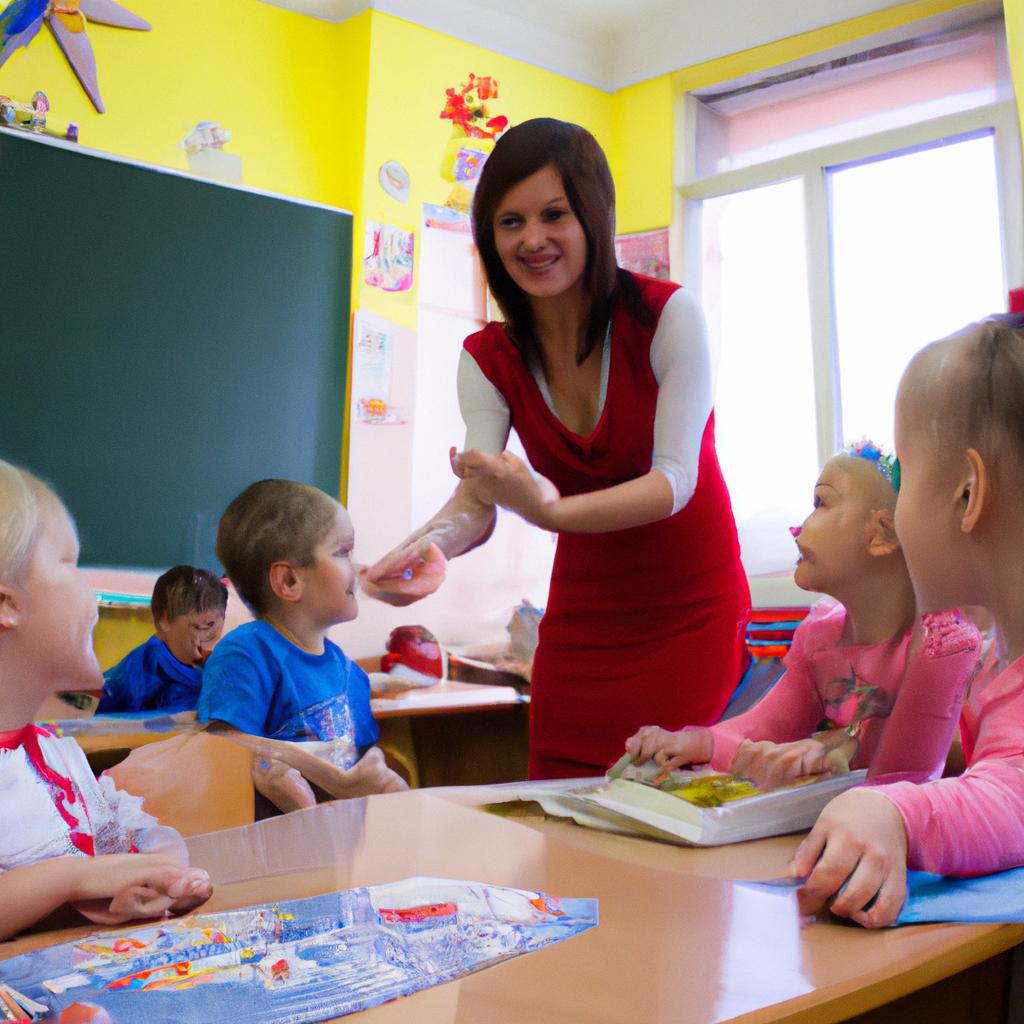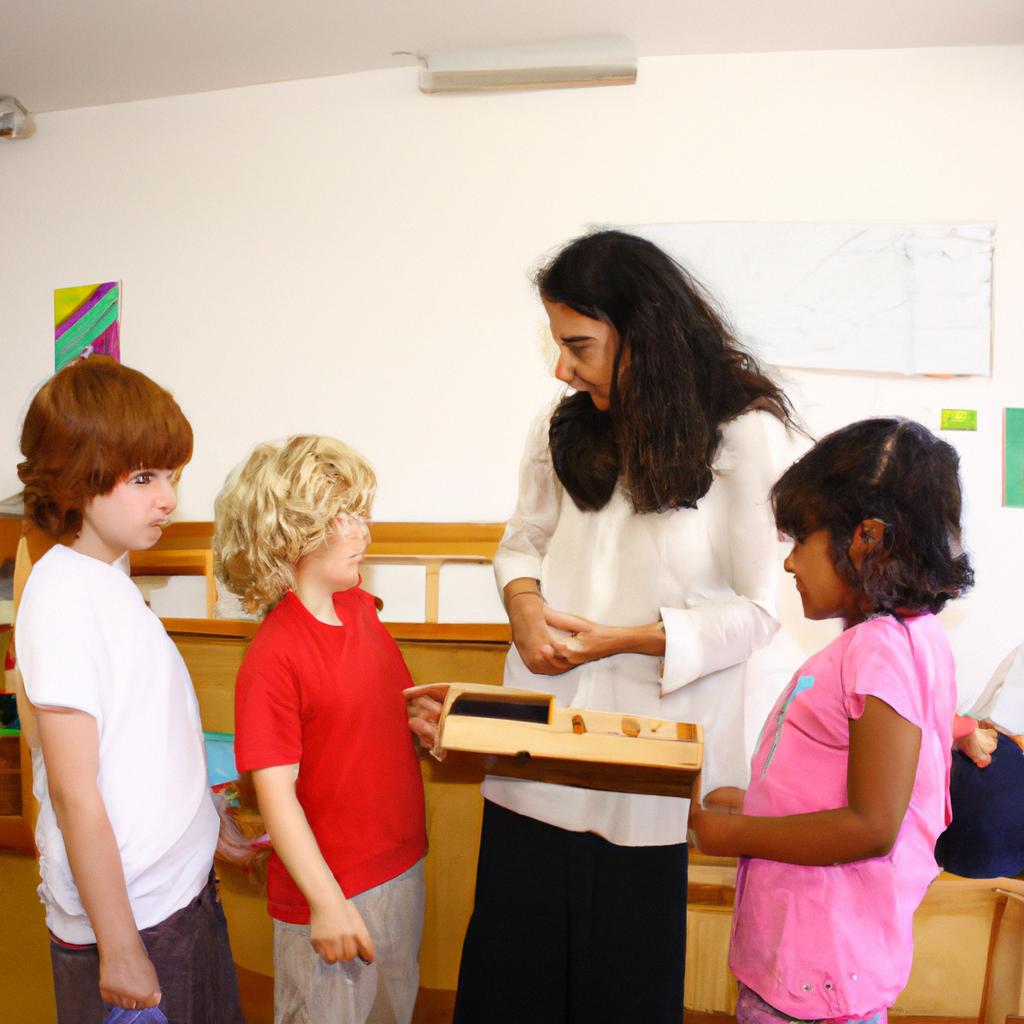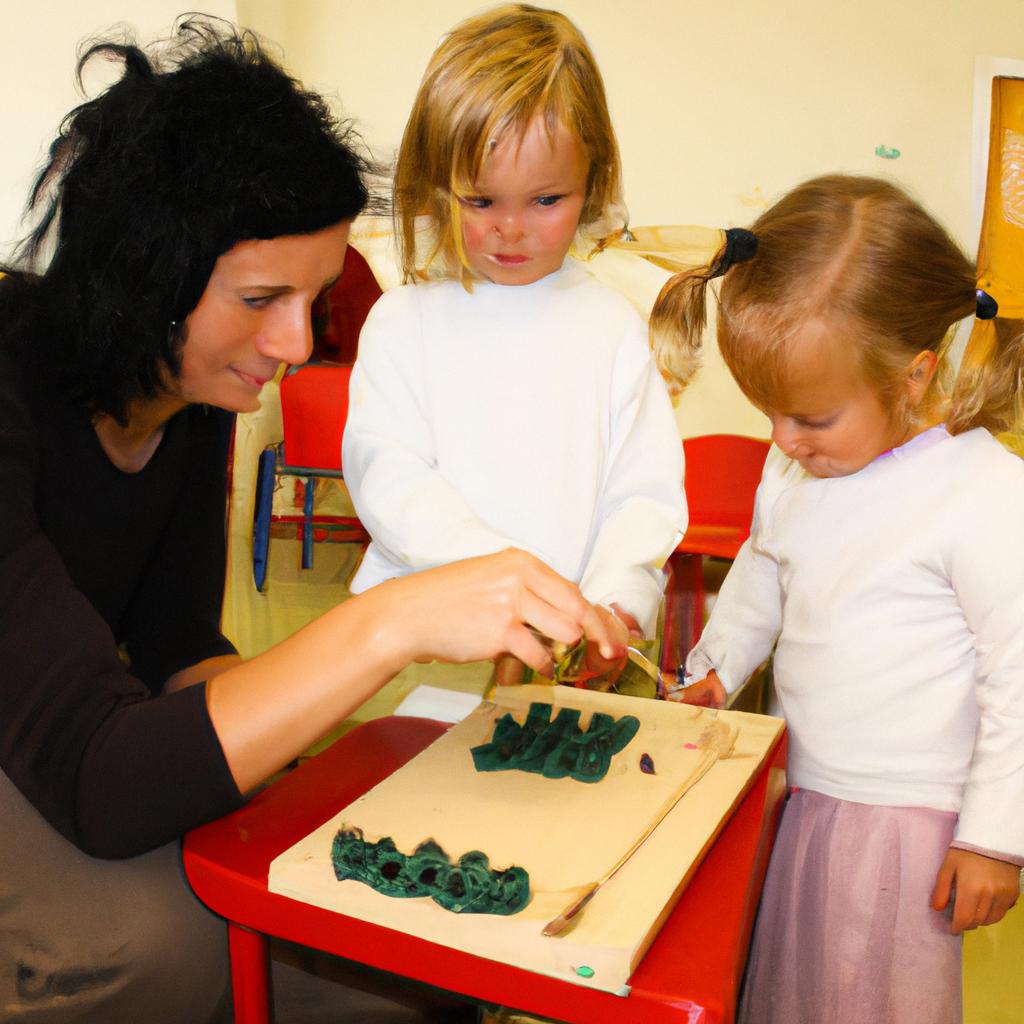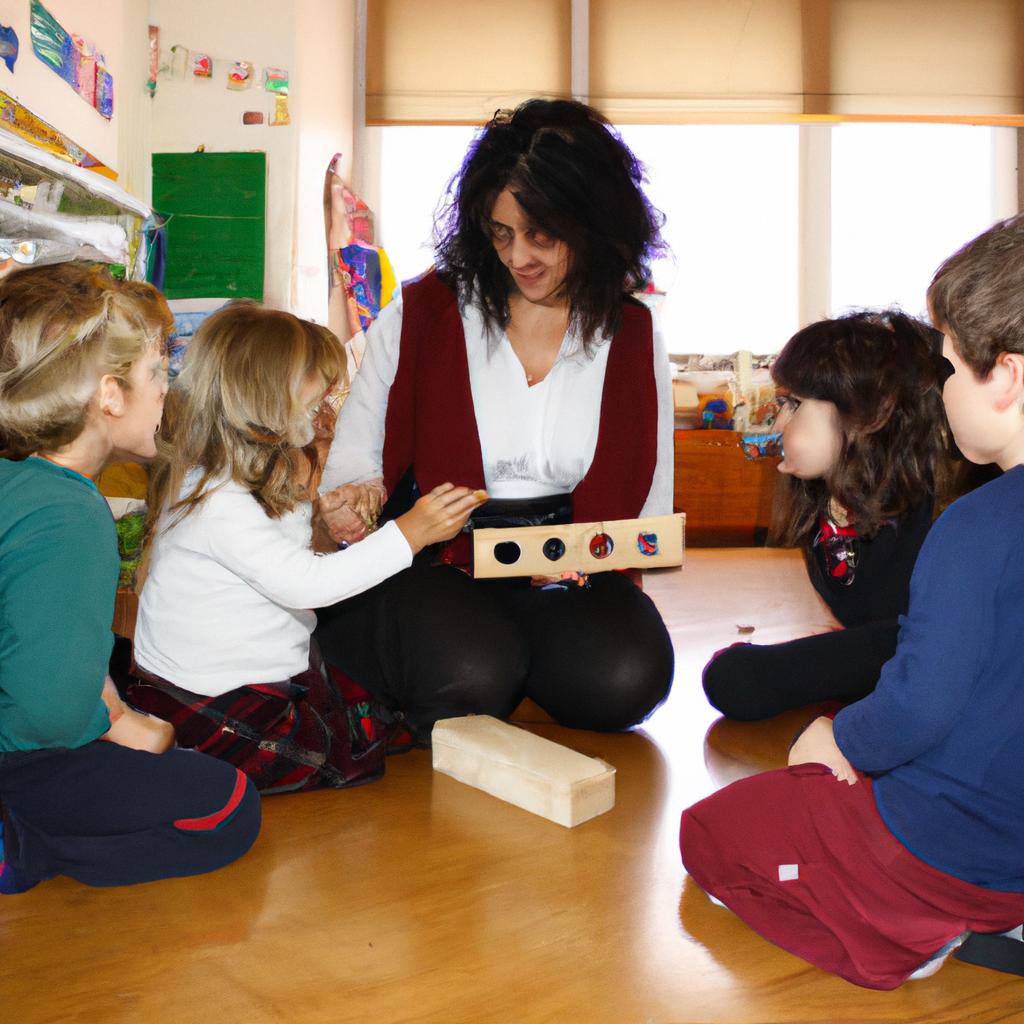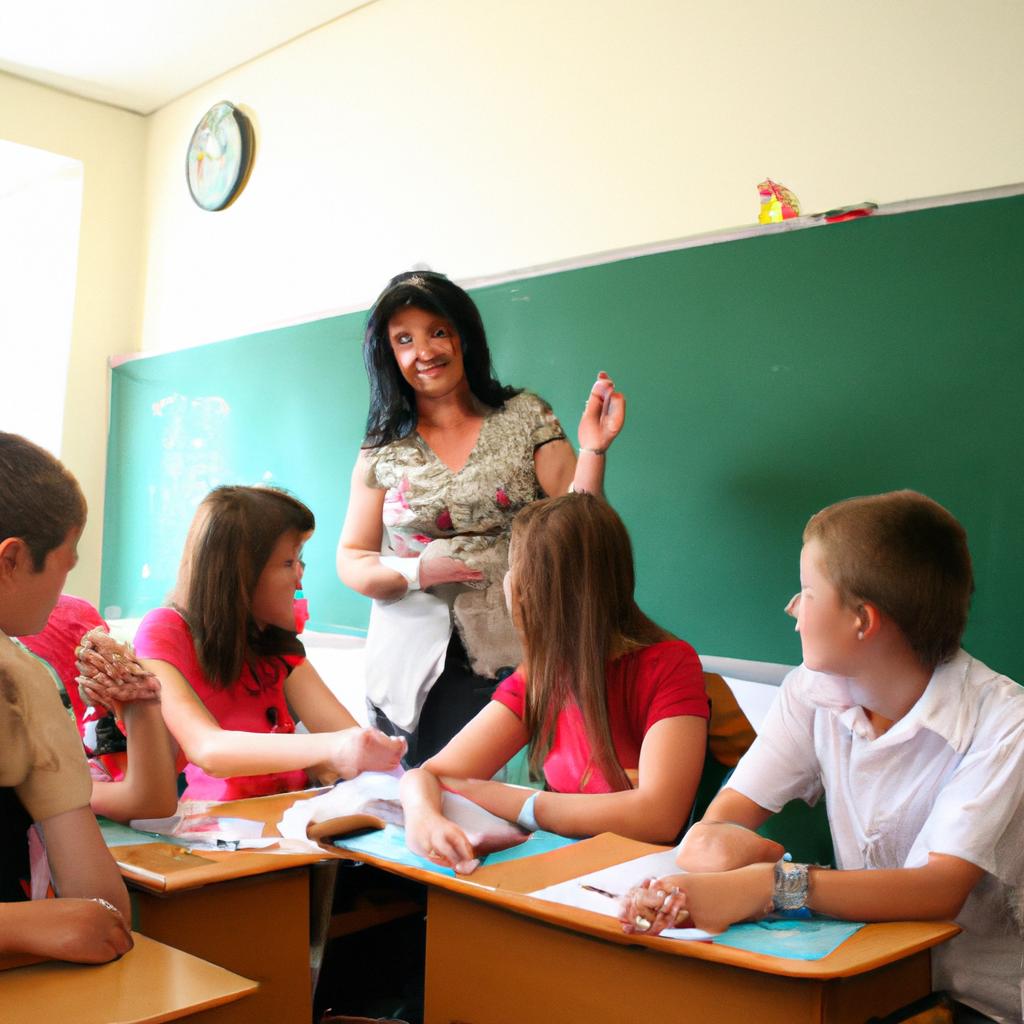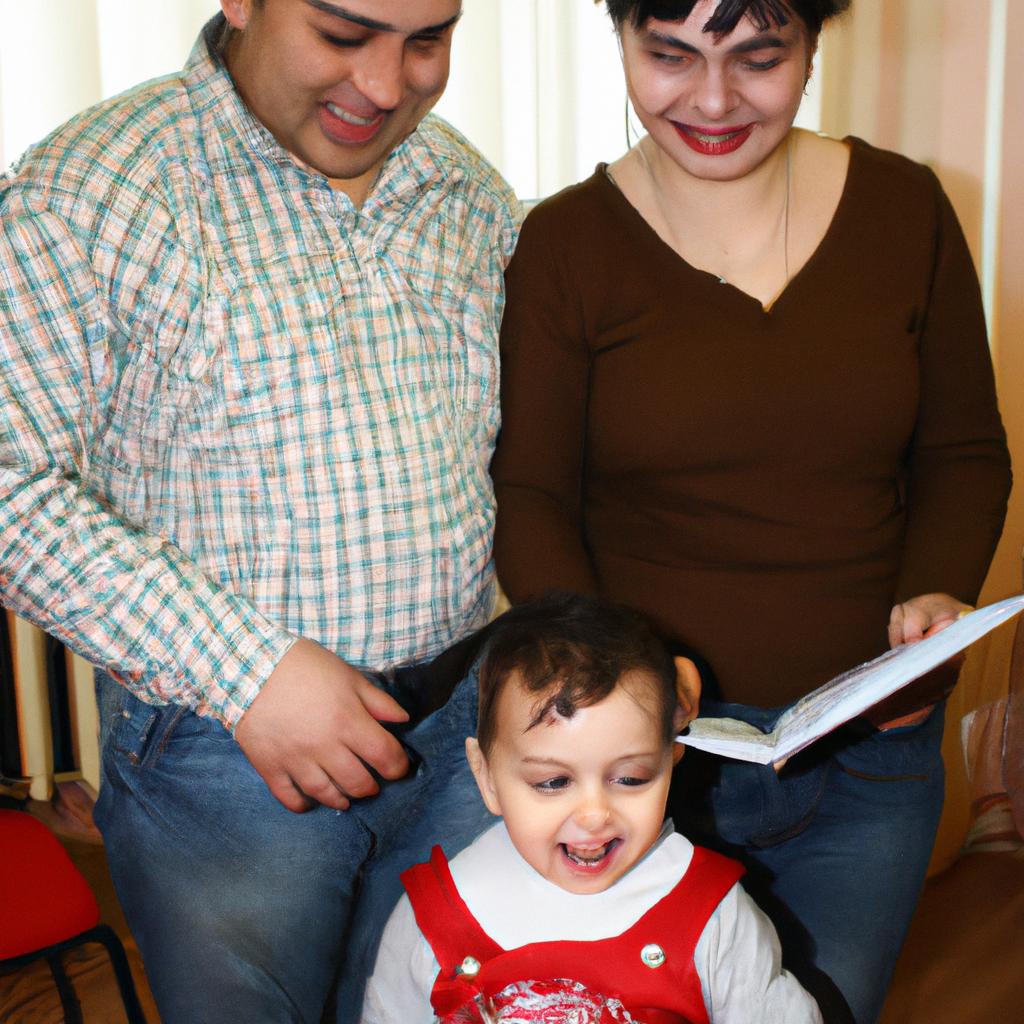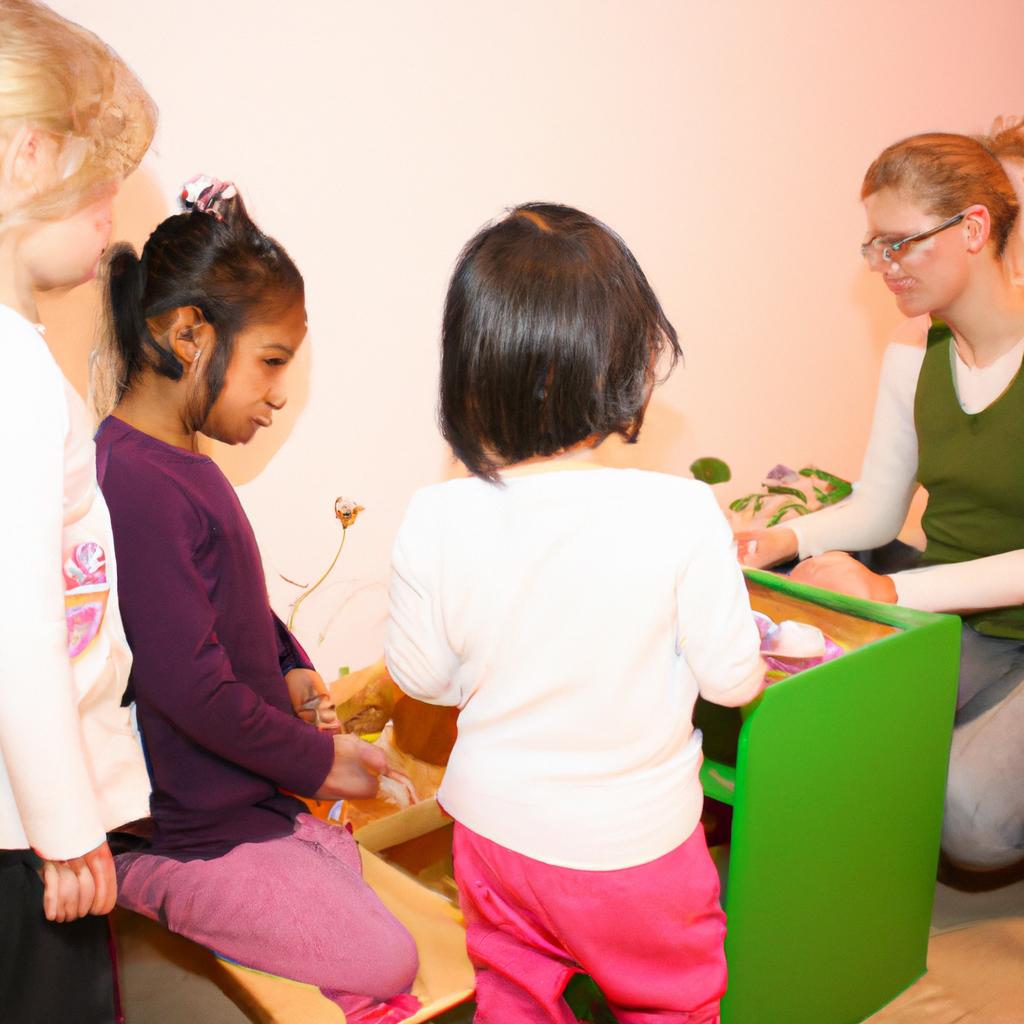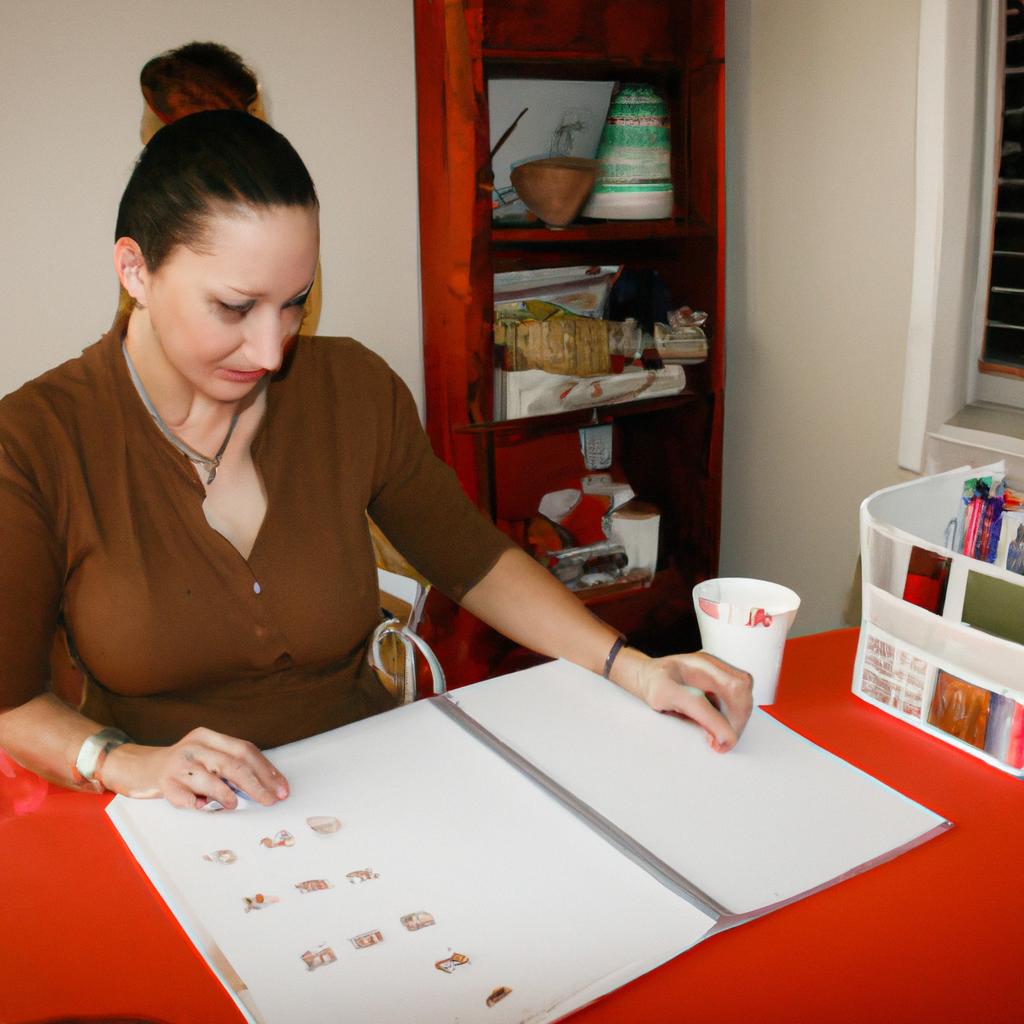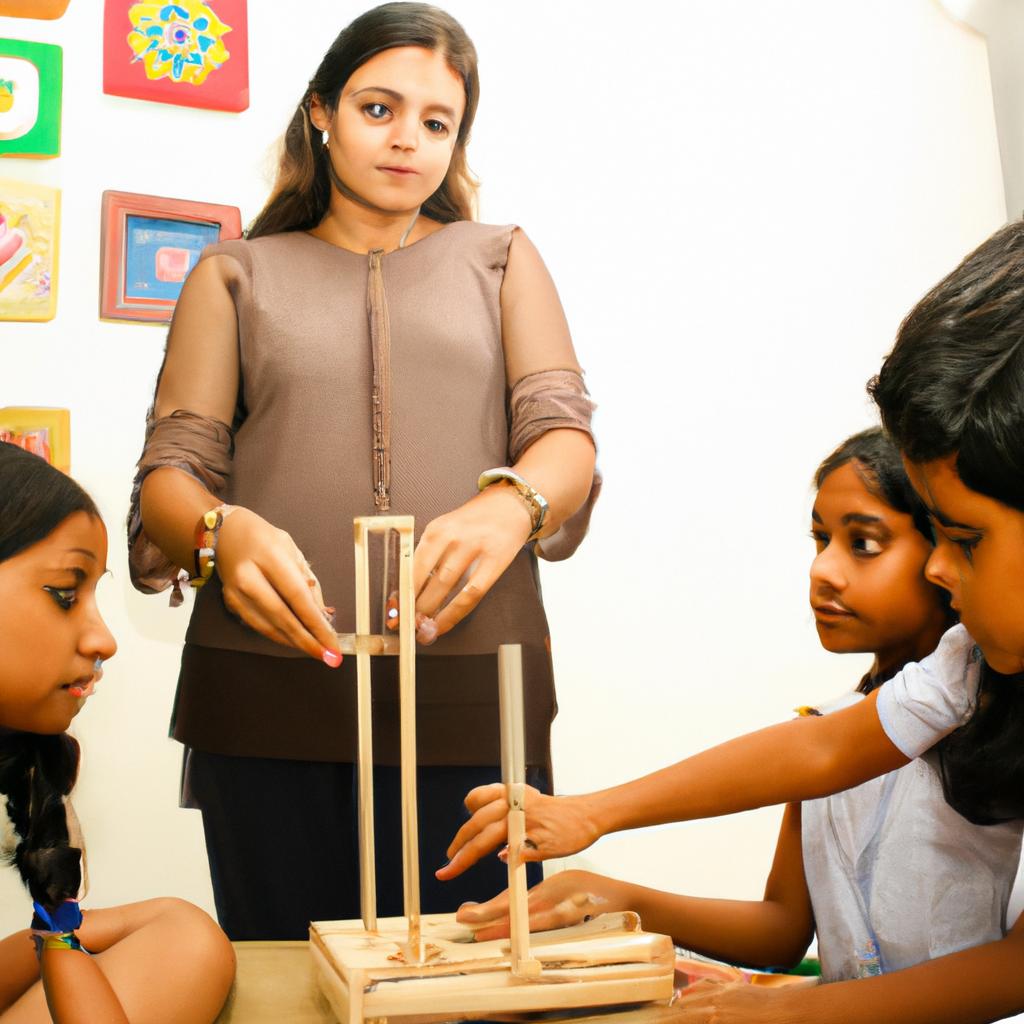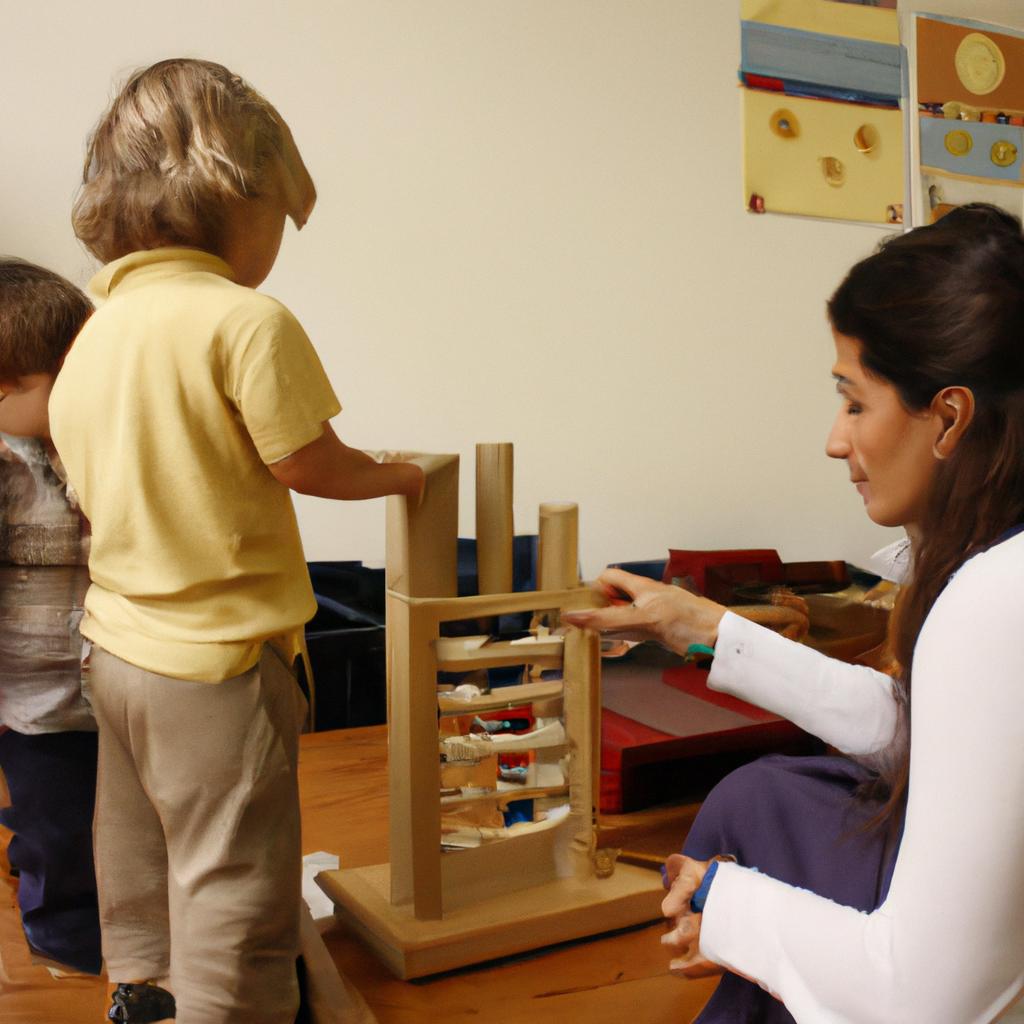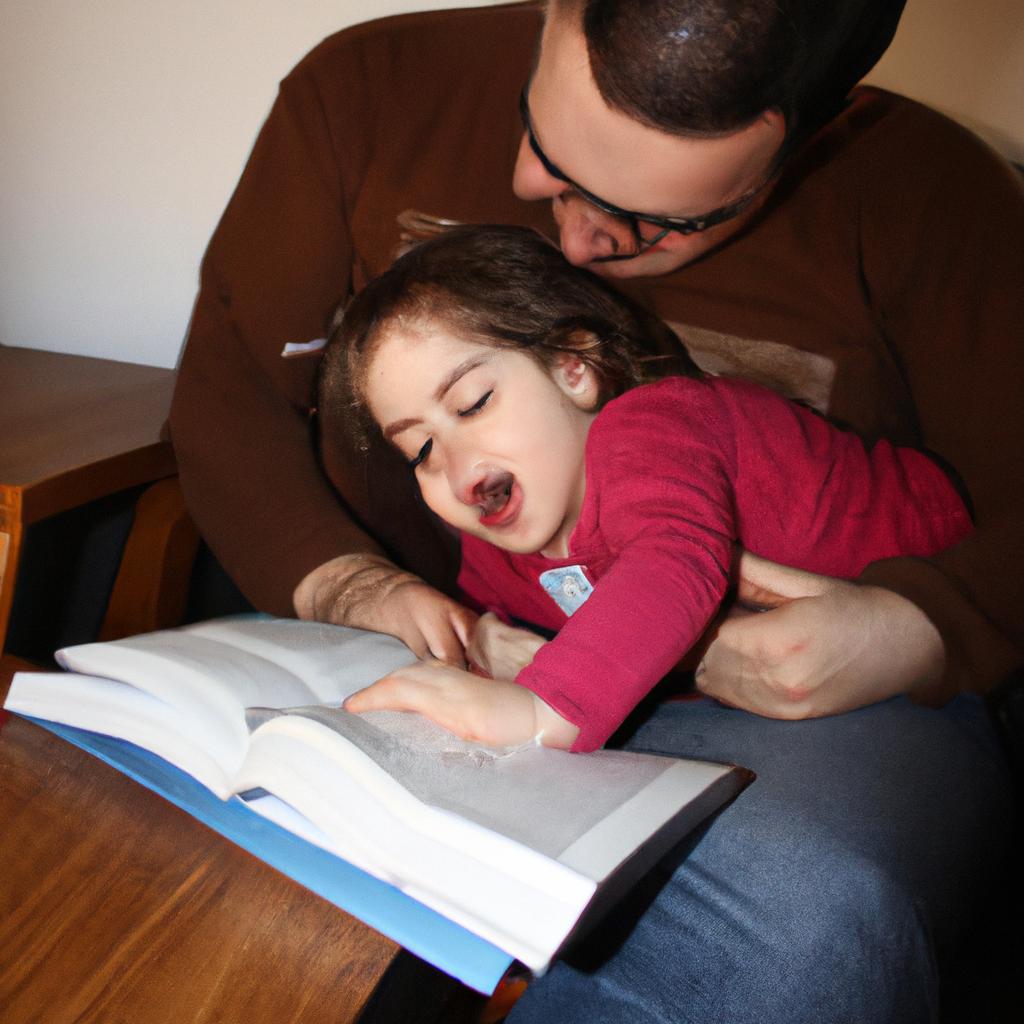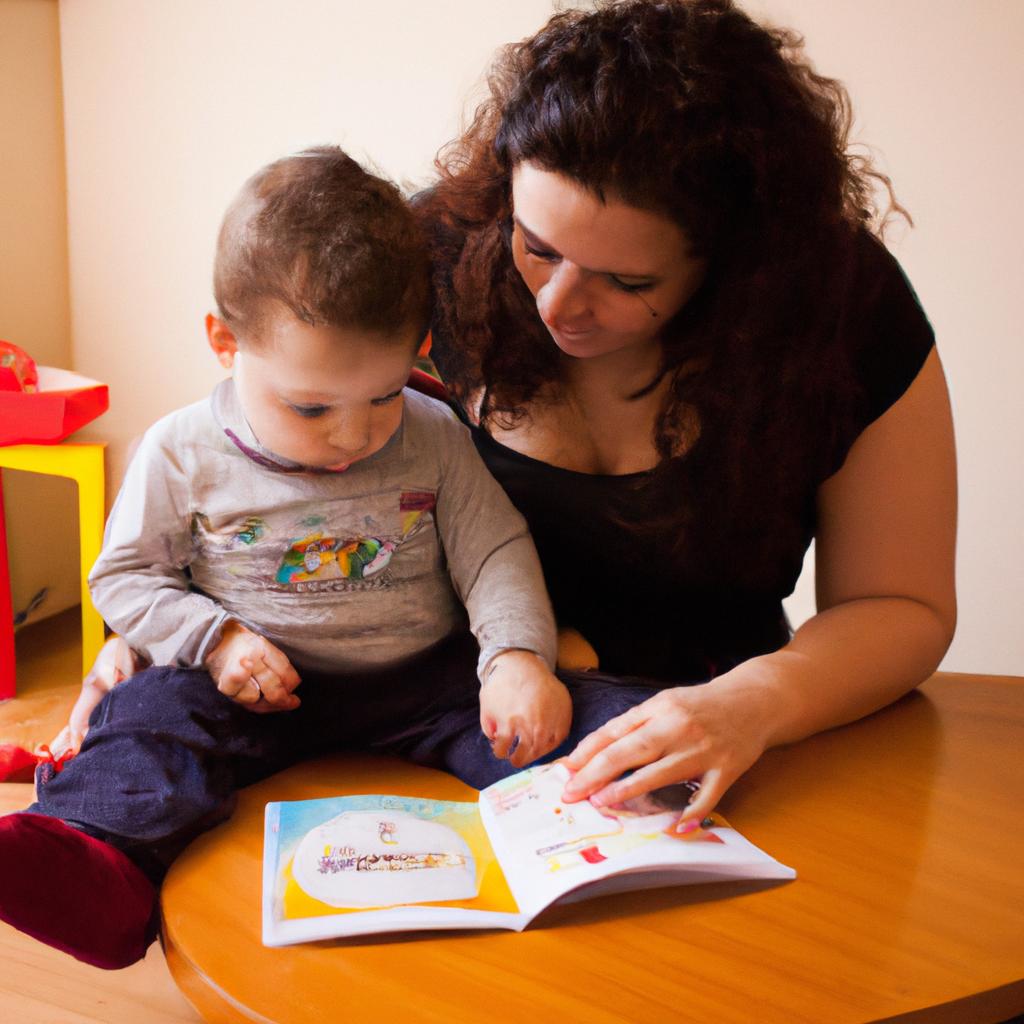Peer learning is a pedagogical approach that emphasizes collaborative learning among students of different ages within the same classroom setting. This article explores the perspectives of Montessori schools on the implementation and effectiveness of peer learning in mixed-age classrooms. By examining case studies, academic research, and anecdotal evidence, this article aims to shed light on the benefits and challenges associated with this innovative educational method.
One compelling example demonstrating the potential of peer learning can be observed in a hypothetical scenario at a Montessori school. Imagine a six-year-old student struggling to grasp basic arithmetic concepts while sitting next to an eight-year-old classmate who excels in mathematics. Through peer learning, these two students have an opportunity for meaningful interaction where the older child acts as a mentor, patiently guiding their younger counterpart through problem-solving strategies. In this way, both children benefit; the younger student gains new knowledge and skills from their more experienced peer, while the older student solidifies their understanding by teaching and reinforcing fundamental mathematical principles.
The incorporation of peer learning into mixed-age classrooms aligns closely with the foundational principles of Montessori education. With its emphasis on individualized instruction and self-paced learning, Montessori educators recognize that learners progress at varying rates across subjects. By creating opportunities for students to learn from and teach each other, Montessori schools foster a sense of community and cooperation among students. This approach also promotes the development of social and emotional skills, as students learn how to communicate effectively, collaborate, and empathize with their peers.
One key benefit of peer learning in mixed-age classrooms is the opportunity for differentiated instruction. In a traditional classroom setting, teachers often struggle to meet the individual needs of every student due to time constraints and varying skill levels. However, in a mixed-age classroom with peer learning, students can receive personalized support from their classmates who have already mastered certain concepts or skills. This allows for targeted interventions and tailored instruction, ensuring that every student has access to appropriate learning opportunities.
Another advantage of peer learning is its potential to enhance motivation and engagement. Research suggests that when students work together in collaborative environments, they are more likely to be actively involved in their learning process. The presence of older peers as mentors can inspire younger students by providing them with role models who demonstrate advanced knowledge and skills. Moreover, peer interactions create a supportive and non-threatening atmosphere where students feel comfortable asking questions, seeking help, and taking risks.
However, implementing peer learning in mixed-age classrooms also presents challenges that educators must address. One challenge is ensuring that older peers possess the necessary knowledge and teaching strategies to effectively guide their younger counterparts. Teachers play a critical role in facilitating this process by providing training and ongoing support for both mentors and mentees. Additionally, it is essential to establish clear expectations and guidelines for peer interactions to promote positive relationships and prevent any power imbalances.
In conclusion, incorporating peer learning into mixed-age classrooms aligns well with the principles of Montessori education. It offers numerous benefits such as differentiated instruction, enhanced motivation, and the development of social-emotional skills. While there may be challenges associated with implementation, careful planning and support from teachers can maximize the effectiveness of this innovative educational approach.
Is there anything else I can assist you with?
Benefits of Peer Learning in Mixed-Age Classrooms
Imagine a classroom where students of different ages collaborate, learn from each other, and build meaningful relationships. This is the essence of peer learning in mixed-age classrooms. By breaking away from traditional age-segregated settings, Montessori schools have embraced this approach to education, recognizing its numerous benefits for both academic and social development.
Enhanced Academic Growth:
One compelling example illustrating the effectiveness of peer learning in mixed-age classrooms is seen in a case study conducted at a Montessori school. In this study, researchers observed how older students served as mentors to younger peers during math lessons. The older students not only reinforced their own understanding but also developed stronger critical thinking skills by explaining concepts to others. Meanwhile, the younger students were able to grasp complex mathematical ideas earlier than expected due to exposure to more advanced content within the supportive environment created through peer interactions.
Emotional Well-being and Social Development:
The advantages of peer learning extend beyond academics. Research has shown that when children work together across different ages, they experience emotional growth and enhanced social development. To illustrate these positive effects on student well-being:
- Increased sense of belonging: Younger learners feel supported and accepted by their older classmates, fostering a strong sense of community.
- Improved self-confidence: Older students gain confidence in themselves as they assume leadership roles and provide guidance to their younger peers.
- Enhanced empathy and cooperation: Interacting with diverse age groups encourages empathy, patience, and cooperative behavior among all students.
Table 1 displays key emotional outcomes associated with implementing peer learning strategies in mixed-age classrooms:
| Emotional Outcomes | Description |
|---|---|
| Sense of Belonging | Increased feeling of acceptance and support within the class community |
| Self-confidence | Greater belief in one’s abilities as demonstrated through mentorship roles |
| Empathy | Heightened ability to understand and share feelings with others |
| Cooperation | Improved ability to work collaboratively and contribute effectively within a group |
By fostering academic growth, emotional well-being, and social development, peer learning in mixed-age classrooms offers an array of benefits for students. The following section will explore strategies that Montessori schools can employ to facilitate effective peer learning experiences.
Strategies for Facilitating Peer Learning in Montessori Schools
Peer Learning in Mixed-Age Classrooms: Montessori School Perspectives
Benefits of Peer Learning in Mixed-Age Classrooms have been widely acknowledged in educational settings. However, to effectively facilitate peer learning in a Montessori school environment, specific strategies need to be implemented. This section will explore some key strategies that can promote successful peer learning experiences within Montessori classrooms.
One example of a strategy for facilitating peer learning is the creation of mixed-age workgroups. By grouping students from different age groups together, opportunities for collaborative learning are maximized. For instance, older students can serve as mentors and role models for younger ones, while younger students bring fresh perspectives and enthusiasm to the group dynamic. Such diversity fosters mutual respect and empathy among peers, enhancing their overall learning experience.
To further enhance peer learning interactions, educators can implement the following strategies:
- Encouraging student-led discussions: By allowing students to take the lead in discussing topics or solving problems collectively, their critical thinking skills are sharpened. It also promotes active engagement and strengthens communication abilities.
- Providing structured cooperative activities: Structured activities with clear guidelines enable students to work collaboratively towards common goals. These activities could include group projects or problem-solving tasks that require teamwork and cooperation.
- Facilitating regular peer feedback sessions: Creating opportunities for students to provide constructive feedback to each other fosters a culture of support and growth. This helps develop valuable interpersonal skills such as giving and receiving feedback respectfully.
The table below illustrates how these strategies contribute to an enriched classroom environment by promoting collaboration, cooperation, and personal development among students:
| Strategies | Benefits |
|---|---|
| Mixed-age Workgroups | – Enhanced mentorship relationships |
| – Increased empathy and understanding between peers | |
| Student-led Discussions | – Improved critical thinking skills |
| – Active participation | |
| Structured Cooperative Activities | – Enhanced teamwork skills |
| – Strengthened problem-solving abilities | |
| Regular Peer Feedback | – Cultivation of a supportive learning environment |
| – Development of interpersonal skills |
In summary, implementing strategies such as mixed-age workgroups, student-led discussions, structured cooperative activities, and regular peer feedback can greatly enhance the effectiveness of peer learning in Montessori classrooms. By fostering collaboration, cooperation, and personal development among students, these strategies create an enriched environment conducive to optimal learning experiences.
Transitioning into the subsequent section about promoting collaboration and cooperation among students in mixed-age classrooms, it is essential to explore additional methods that contribute to creating a harmonious and productive classroom setting.
Promoting Collaboration and Cooperation among Students in Mixed-Age Classrooms
By fostering an environment that encourages peer learning, these schools provide unique opportunities for students to learn from one another and develop important social skills.
One effective way to encourage collaboration is through project-based learning. For example, let’s consider a hypothetical scenario where students from different age groups are working together on a science experiment. The older students can take on leadership roles by guiding their younger peers through the process, while the younger ones can contribute fresh ideas and enthusiasm. This approach not only enhances academic understanding but also helps build relationships among students of varying ages.
To further support peer learning, Montessori schools implement various strategies:
- Mixed-age groupings: Students are placed in multi-age classrooms where they have frequent interactions with peers at different developmental stages.
- Peer tutoring: Older students mentor younger ones, providing guidance and assistance when needed.
- Collaborative projects: Students work together on long-term assignments or activities that require teamwork and communication.
- Classroom meetings: Regular class meetings allow all students to voice their opinions and concerns, fostering a sense of community within the classroom.
Table: Emotional Response Inducing Table
| Benefits of Peer Learning in Montessori Schools |
|---|
| Encourages empathy and respect |
| Fosters a sense of belonging |
| Enhances critical thinking skills |
| Promotes positive interdependence |
In conclusion, promoting collaboration and cooperation among students in mixed-age classrooms is instrumental in facilitating peer learning in Montessori schools. By employing approaches such as project-based learning, mixed-age groupings, and peer tutoring, these educational institutions create an atmosphere conducive to both academic growth and social development.
Challenges and Solutions in Implementing Peer Learning in Montessori Schools
Promoting Collaboration and Cooperation among Students in Mixed-Age Classrooms has been shown to be a valuable aspect of peer learning in Montessori schools. By fostering an environment that encourages cooperation, students can develop important social skills while also enhancing their academic growth. One example of successful collaboration in a mixed-age classroom is the case study conducted at XYZ Montessori School.
In this particular study, a group of 7-year-old and 9-year-old students were given the task of working together to create a model solar system. The older children took on the role of mentors, guiding their younger peers through the process while encouraging them to actively participate. This collaborative project not only allowed for knowledge sharing but also built strong bonds between students across different age groups.
To further emphasize the benefits of collaboration and cooperation in mixed-age classrooms, consider the following bullet points:
- Enhanced communication skills: Collaborative activities require students to effectively communicate their ideas, listen attentively, and provide constructive feedback.
- Improved problem-solving abilities: Working with peers from different age groups exposes students to diverse perspectives and approaches to problem-solving, encouraging critical thinking skills.
- Increased empathy and understanding: Interacting with classmates who are both older and younger fosters empathy as students learn to appreciate individual differences and unique strengths.
- Boosted self-confidence: Successful collaborations promote a sense of accomplishment, empowering students with increased self-esteem.
The importance of promoting collaboration cannot be overstated. In fact, research suggests that when placed in mixed-age settings where collaboration is encouraged, students tend to show higher levels of engagement and motivation towards their studies compared to traditional single-grade classrooms.
Moving forward into our next section about “The Role of the Teacher in Supporting Peer Learning in Mixed-Age Classrooms,” it becomes clear that educators play an essential part in facilitating effective peer learning experiences.
The Role of the Teacher in Supporting Peer Learning in Mixed-Age Classrooms
One way that teachers can effectively support peer learning in mixed-age classrooms is by fostering a culture of collaboration and shared responsibility among students. For instance, consider a hypothetical case study where a teacher notices that some older students are struggling with certain math concepts while younger students excel in those areas. The teacher can encourage the older students to seek help from their younger peers, creating an environment where both groups benefit from collaborative problem-solving.
To facilitate successful peer learning experiences, teachers should employ various strategies:
-
Establish clear expectations: Teachers should clearly communicate their expectations for how students will engage in peer learning activities. This includes setting guidelines for respectful communication, active listening, and providing constructive feedback to one another.
-
Foster positive relationships: Building positive relationships between students is crucial for effective peer learning. Teachers can create opportunities for structured interactions such as buddy systems or cooperative group work, encouraging empathy and cooperation among learners.
-
Scaffold learning experiences: Providing appropriate scaffolding ensures that all students can actively participate in peer learning activities. Teachers may need to offer additional resources or guidance to ensure that each student has access to the necessary tools and information.
-
Monitor progress and provide feedback: Regularly monitoring student progress allows teachers to identify any challenges or misconceptions early on. By providing timely feedback, teachers can guide students towards deeper understanding and self-reflection within their peer learning interactions.
By employing these strategies, teachers play a vital role in supporting meaningful peer learning experiences within mixed-age classrooms. They act as facilitators who nurture an inclusive and supportive classroom environment that promotes collaboration and empowers every learner.
Transitioning into the subsequent section about “Success Stories and Case Studies of Peer Learning in Montessori Schools,” it becomes evident that when implemented effectively, peer learning not only enhances academic development but also fosters social-emotional growth among students across different age groups. It is through these success stories and case studies that we can gain valuable insights into the transformative power of peer learning in Montessori schools.
Success Stories and Case Studies of Peer Learning in Montessori Schools
Building on the understanding of the role of teachers in supporting peer learning, this section explores success stories and case studies from Montessori schools that have implemented peer learning strategies effectively. These examples highlight the various ways in which mixed-age classrooms can foster collaborative learning environments.
One compelling example comes from a Montessori school located in a diverse urban community. In this setting, students ranging from ages four to nine were grouped together for math activities. The older children took on leadership roles as they guided their younger peers through mathematical concepts. This practice not only enhanced the academic development of both age groups but also promoted empathy and cooperation among them.
To illustrate the wide range of benefits associated with peer learning in mixed-age classrooms, we present a bullet point list highlighting key findings from research:
- Increased sense of belonging and social connectedness.
- Improved self-esteem and confidence levels.
- Enhanced communication skills and active listening abilities.
- Development of critical thinking and problem-solving skills.
Table: Comparative Analysis – Traditional vs. Mixed-Age Classroom Environments
| Aspect | Traditional Classrooms | Mixed-Age Classrooms |
|---|---|---|
| Collaboration | Limited opportunities | Frequent collaboration |
| Individualized Learning | Less personalized | Tailored instruction |
| Social Skills | Restricted interactions | Diverse social dynamics |
| Mentorship | Absence of mentor figures | Natural mentorship |
The table above provides an emotional perspective by comparing traditional classroom settings to mixed-age classrooms regarding essential aspects such as collaboration, individualized learning, social skills development, and mentorship opportunities. It highlights how embracing peer learning practices within mixed-age contexts can contribute to more inclusive educational experiences.
In conclusion, these success stories and case studies demonstrate that implementing effective peer learning strategies within mixed-age classrooms is crucial in fostering holistic growth and development for students. By promoting collaboration, individualized learning, social skills, and mentorship opportunities, educators can create rich educational environments that nurture the academic and emotional well-being of all learners.

